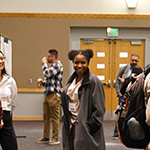NEWS
Watching Seeds Grow

UNM Center for Water and the Environment Trailer
UNM Kim Delker
In 2014, NM EPSCoR supported the hire of Assistant Professors Dr. José Cerrato and Dr. Ricardo González-Pinzón at the UNM Department of Civil, Construction, and Environmental Engineering with funds from the $20 million Energize New Mexico National Science Foundation (NSF) EPSCoR grant.
Almost immediately, both faculty showed great promise and worked as active members of the Uranium Transport and Site Remediation project team tasked with investigating how uranium moves through the environment. Dr. González-Pinzón enthusiastically dove into hydrological modeling frameworks seeking to estimate water budgets based on streamflow data, while Dr. Cerrato served as team lead and investigated how uranium behaved at the interface of soil and water. The two have produced groundbreaking research on the conditions that promote uranium leaching from mine waste that has ramifications for site remediation efforts across the state.
Dr. Cerrato and Dr. González-Pinzón have continued to collaborate after the end of the Energize New Mexico project, and last month were part of a team that received $5 million in NSF CREST Phase II funding for the UNM Center for Water and Environment (CWE), set to begin in January 2020. Phase I of the CREST CWE was started in 2013 by Professor Kerry Howe from the Department of Civil, Construction, and Environmental Engineering. In Phase II, Dr. Howe will continue to serve as principle investigator but is slated to share the role with co-principal investigators Andrew Schuler, Mark Stone, José Cerrato, and Ricardo González-Pinzón.
Together they hope to continue research work begun under Phase I and increase the participation of underrepresented minority populations in STEM fields.
For their part, Dr. Cerrato and Dr. González-Pinzón are excited, and while this most recent professional achievement is entirely a product of their own sweat, blood, and tears, both academics also NM EPSCoR in their success.
"I believe the experience and skills I gained as Uranium Team lead on the previous NM EPSCoR project have prepared me well for larger opportunities like this one,” Dr. Cerrato explained.
Dr. González-Pinzón agrees, adding, "The impacts of NM EPSCoR do not end when a project ends. For example, the collaborative research that we began with the Energize New Mexico grant grew into an excellent professional relationship, and now we are Co-PIs on a $5 million NSF grant.
It’s statements like these that make previous NM EPSCoR Associate Director and Co-PI, Dr. Mary Jo Daniel, who is now Director of the Faculty Research Development Office at UNM, absolutely beam.
“This is exactly what we wanted to happen,” Dr. Mary Jo Daniel explains.
“The primary goal of NM EPSCoR is to build research capacity in the state. UNM hired these two promising researchers with support from the Energize New Mexico EPSCoR grant, and now they are filling leadership roles in a large, collaborative NSF research center. It is great to see.”
Indeed it is. Congratulations to the UNM Center for Water and the Environment on this Phase II funding, and for helping make NM EPSCoR seeds grow. Learn more by reading the official UNM press release.

